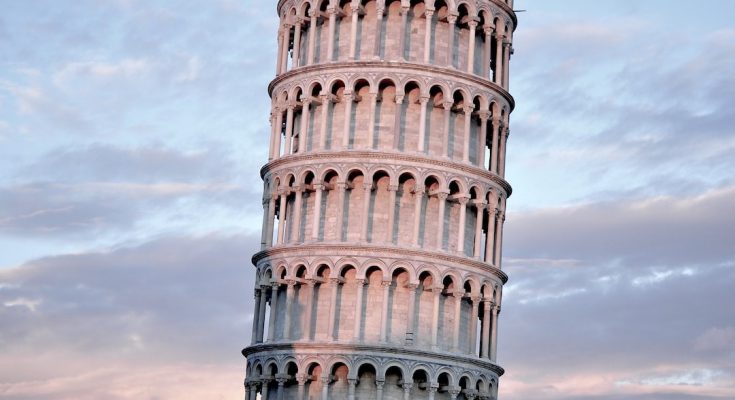The Leaning Tower of Pisa is an iconic monument that has been standing since 1173, yet its construction and history remain shrouded in mystery. What causes this tower to lean? Why did it take almost two centuries for the structure to be completed? How have preservation efforts helped maintain its cultural significance over time? These are all questions we will explore as we dive into the leaning tower of pisa history. We’ll look at when and why it was built, what caused it to lean, how restoration projects kept it safe from further damage, and some interesting facts about this architectural marvel that you may not know. So join us on a journey through time as we uncover the secrets behind one of Italy’s most beloved monuments!
Table of Contents:
- Construction of the Leaning Tower of Pisa
- Causes of the Lean
- Preservation Efforts and Restoration Projects
- Cultural Significance and Popularity of the Leaning Tower of Pisa
- Interesting Facts About the Leaning Tower of Pisa
- FAQs in Relation to The Leaning Tower of Pisa History
- Conclusion
Construction of the Leaning Tower of Pisa
Designed by architect Diotisalvi and built between 1173 and 1372, it stands as a testament to the architectural ingenuity of its time. The tower is constructed from limestone and lime mortar, with eight stories reaching a height of 56 meters.
Architectural Design
The Leaning Tower was designed in the Romanesque style that was popular during the 12th century. It features round arches, columns with capitals decorated with foliage motifs, blind arcades on each story, and two small galleries at the top. The walls are also decorated with intricate carvings depicting religious scenes such as Christ’s Ascension into Heaven or Mary holding Jesus’ body after his death on the cross.
Materials Used
Limestone blocks were used for construction along with lime mortar which provided flexibility to help prevent cracking due to settling over time. This material combination allowed for greater stability than other building materials available at that time period such as brick or wood beams which would have been more prone to shifting over time due to weathering or decay caused by insects or fungi.
Building Process
Construction began in 1173 but did not finish until 1372 when Galileo Galilei famously performed experiments involving dropping weights from different heights within its walls while studying gravity and motion laws he had formulated earlier in life. During this process, workers noticed that one side of the tower seemed lower than another, causing it to lean towards one direction instead of standing straight up like most towers do today. As work progressed, they tried their best to correct this problem; however, despite their efforts, it still leaned slightly off center making it what we know today as “the leaning tower of Pisa”.
The Leaning Tower of Pisa is an iconic structure, and its construction was a feat of engineering. Despite the complex design and materials used, the tower’s foundation ultimately caused it to lean due to uneven settling and poorly compacted soil – both factors that will be discussed in more detail in the next heading.
Key Takeaway: The Leaning Tower of Pisa is an iconic structure constructed from limestone and lime mortar in the Romanesque style. Despite workers’ efforts to correct it, it still leaned slightly off center making it what we know today as “the leaning tower of Pisa”. Key elements: – Architectural design – Materials used – Building process
Causes of the Lean
The tower’s lean, however, was not intentional and is due to a number of factors.
Uneven Settling of Foundation: One primary cause for the lean is due to an uneven settling of its foundation caused by poorly compacted soil. This led to one side sinking more than the other which created the tilt we see today. Poorly compacted soil can occur when there are too many large stones in a layer or if it wasn’t properly leveled before construction began on the tower.
Poorly Compacted Soil: In addition to this, poor compaction can also be attributed to environmental conditions such as heavy rain or flooding during construction which would have weakened and destabilized the ground beneath it leading to further settlement issues on one side compared with another.
Geology of the Area: Lastly, geology plays a role in why the Leaning Tower leans so much today as well. It’s built upon soft clay soils that compress easily under pressure making them prone to subsidence and movement over time which explains why it continues leaning even after centuries since its initial construction started in 1173 AD.
These three main causes all contributed towards creating what we now know as “the leaning tower” – an architectural marvel that stands tall despite its obvious tilt. It is a testament to the ingenuity of its builders and serves as a reminder of how much can be achieved with careful planning and consideration.
The leaning tower of Pisa is an architectural marvel, and its unique tilt has been caused by a combination of factors. Understanding the causes behind the lean can help us better understand how to preserve and restore this iconic structure for future generations.
“Don’t let the lean fool you. The Leaning Tower of Pisa has been standing strong for over 800 years, thanks to its clever builders and careful planning. #LeaningTowerOfPisa #HistoryLesson Click to Tweet
Preservation Efforts and Restoration Projects
Stabilization Techniques Used to Prevent Further Tilting: In order to prevent the Leaning Tower of Pisa from tilting any further, a variety of stabilization techniques have been used since 1990. The most common technique is soil extraction from beneath the tower’s foundation. This process involves removing some of the soil underneath the tower in order to reduce its weight and lessen its tilt. Other stabilization techniques include using steel cables and rods to reinforce the structure, as well as installing concrete piles around it for additional support.
In addition to stabilization techniques, structural modifications have also been made in an effort to strengthen the tower’s foundation and make it more resistant against future movements caused by seismic activity or other external forces. These modifications include reinforcing existing walls with metal bars, adding new foundations on top of old ones, and increasing internal buttressing with masonry blocks. All these efforts are aimed at ensuring that no further damage is done to this iconic landmark over time.
Preservation efforts and restoration projects have been ongoing for decades to prevent further tilting of the tower. Now, let’s take a look at its cultural significance and popularity as a tourist attraction.
The Leaning Tower of Pisa has been through a lot, but it’s standing strong thanks to some clever stabilization techniques. #Pisa #TowerOfStrength Click to Tweet
Cultural Significance and Popularity of the Leaning Tower of Pisa
It has become a symbol for Italian culture, with millions visiting it each year as a tourist attraction. The tower was declared a UNESCO World Heritage Site in 1987 due to its historical significance.
The construction of the tower began in 1173 under architect Bonanno Pisano, but stopped abruptly after just three stories were built due to war and other political unrest at that time. Construction resumed almost 100 years later when Giovanni di Simone took over as architect, completing the eight-story structure by 1350. Since then, it has been an important part of Italian history and culture, inspiring many artists throughout centuries such as Galileo Galilei who conducted experiments on gravity using balls rolling down its stairs during his studies there from 1589 to 1591.
Today, visitors flock to see this famous leaning tower which stands at 56 meters tall (184 feet). Despite numerous attempts to stabilize it since its completion 700 years ago, including several major restoration projects between 1990-2001 which reduced its tilt by 45 cm (18 inches), it still leans at an angle of 4 degrees making it one of the most recognizable monuments worldwide. This unique architectural feat draws thousands every day who come to marvel at this incredible engineering achievement while learning about its rich cultural heritage through guided tours or simply taking pictures with friends and family against this stunning backdrop.
The Leaning Tower of Pisa has become a symbol of Italy, and is one of the most visited tourist attractions in the world. Its unique tilt makes it an iconic landmark that has captured people’s imaginations for centuries. Next, let’s explore some interesting facts about this famous structure.
“Take a trip to the Leaning Tower of Pisa and experience 700 years of history. It’s an engineering feat that still stands tall, despite its 4 degree tilt. #LeaningTowerOfPisa #ItalianHistory #Travel” Click to Tweet
Interesting Facts About the Leaning Tower of Pisa
Standing at 56 meters tall, it has become an icon for its unique tilt that has been present since its construction began in 1173. Its weight is estimated to be 14,500 tons and it has dimensions of 15 x 15 meters at the base.
Underneath the tower lies 294 steps leading up to its bell chamber containing seven bells which are still rung today by hand-pulling ropes attached to them. An inner spiral staircase with 293 steps leads up to the top floor balcony where visitors can enjoy stunning views over Pisa and beyond.
What makes this monument so special is that it features two distinct architectural styles – Romanesque on lower levels and Gothic on upper levels – making it a truly remarkable structure from both inside and out. The leaning aspect was not intentional but rather due to poor foundation work caused by soft ground below which shifted during construction causing one side of the tower’s foundations to sink more than the other resulting in its famous lean angle of 3.99 degrees.
Despite numerous attempts throughout history, engineers have yet been able to successfully stabilize or correct this lean without compromising any part of the structure itself or surrounding area, making it an even more impressive feat considering how long ago it was constructed.
The Leaning Tower of Pisa has been leaning since 1173. Its unique tilt is a testament to the engineering prowess of its builders. #LeaningTowerOfPisa #History Click to Tweet
FAQs in Relation to The Leaning Tower of Pisa History
What caused the Leaning Tower of Pisa to lean?
The underlying cause is believed to be a combination of soft ground on one side and the weight of the tower itself, which caused it to begin sinking into the ground on one side. This uneven foundation has caused the tower to tilt over time, with its angle increasing by 4 degrees since it was first built. Despite numerous attempts at stabilization, it continues to lean today and remains an iconic symbol of Italy’s rich history.
Who built the Leaning Tower of Pisa and why?
The Leaning Tower of Pisa was built by Bonanno Pisano, a 12th century Italian architect and engineer. He was commissioned to build the tower as part of a larger complex in the city of Pisa, Italy. The foundation for the tower was laid in 1173 but construction halted due to wars and other conflicts until completion in 1372. Over time, the soft ground beneath it caused it to lean at an angle that has become its most recognizable feature today.
What are 3 interesting facts about the Leaning Tower of Pisa?
1. The Leaning Tower of Pisa is a freestanding bell tower located in the Italian city of Pisa. It was built between 1173 and 1372 and has become one of the most iconic landmarks in the world due to its distinctive tilt, which began during construction.
2. The lean of the tower is caused by an inadequate foundation on ground that was too soft on one side to properly support the structure’s weight. Despite numerous attempts to correct it over centuries, it still leans at an angle of 3.99 degrees today.
3. In 1987, UNESCO declared the Leaning Tower of Pisa as a World Heritage Site along with other monuments in Italy’s historic centre including the Cathedral Square and Baptistery buildings near it.
What keeps the Leaning Tower of Pisa from falling?
The Leaning Tower of Pisa is kept from falling by a complex system of counterweights and stabilizing elements. The foundation of the tower was built on weak, unstable soil which caused it to lean at an angle when construction began in 1173. To counteract this, engineers installed lead weights on one side and removed earth from the other side to balance out the weight distribution. Additionally, two iron chains were placed around the third level of the tower to provide extra stability. Finally, a number of restorations have been completed over time to further strengthen its structure and ensure that it remains standing for centuries to come.
Conclusion
It’s construction began in 1173, and it has been leaning ever since due to its foundation of limestone and lime mortar settling unevenly. Over the years, preservation efforts have helped keep this iconic landmark standing strong despite its lean. The tower is now an important cultural symbol for Italy, as well as a popular tourist destination. From its unique design to its fascinating history, there are many interesting facts about the Leaning Tower of Pisa that make it an incredible piece of architecture worth learning more about.
Do you want to know more about the history of the Leaning Tower of Pisa? Check out InterestingFacts.org for fun facts, interesting trivia and general knowledge that will help spark conversations about this iconic landmark! Our website offers reliable information on topics such as science, technology and even conversation starters – all in one convenient place. So come explore our site today to learn more about the fascinating story behind the Leaning Tower of Pisa!



